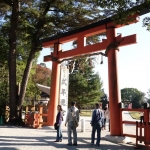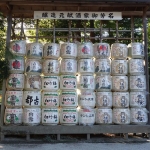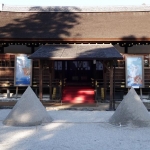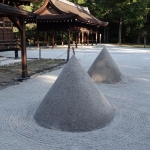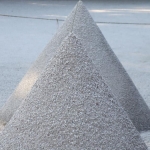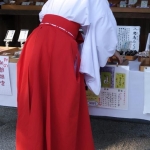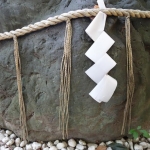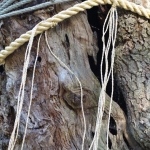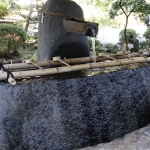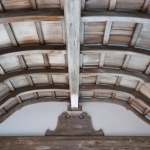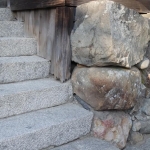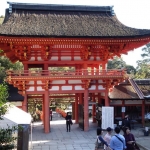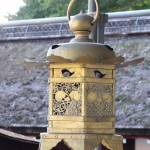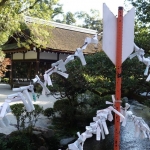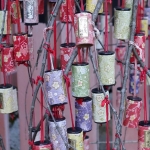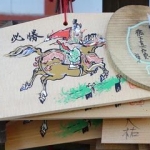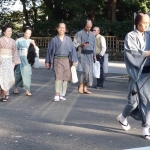Kamigamo-jinja
In this world of ours
As we cross from shore to shore
We should keep out thoughts
as unsullied as
Flowing water.
–Rengetsu
The Kamo Shrines, Shimogamo Shrine and Kamigamo Shrine, are both recognized as UNESCO World Heritage Sites. They are two of the most important and oldest shrines in Kyoyo.
In fact, the Kamo Shrines even predate the city’s establishment as national capital in 794. Throughout the thousand years that Kyoto served as Japan’s capital city, the Imperial Court patronized the shrines as establishments dedicated to the city’s protection and prosperity.
Kamo-wake-ikazuchi-Jinja in the Kita Ward of Kyoto is the oldest Shinto shrine in the ancient city. Since prehistoric times Kamigamo-jinja has preserved and transmitted the legends relating to the birth of the shrine deity, Wakeikazuchi.
Ancient rituals which transmit faith in the divine mountain, Kamo Sai, also known as Aoi Matsuri, started during the reign of Emperor Kinmei in 544. The shrine buildings retaining the style of the early Heian Period, all convey the history of the province of Yamashiro (southern Kyoto Prefecture).
Most of the shrine complex has been designated as a Preservation Area of Historic Landscape by the municipal government and as a Historic Site by the national government. The area contains many large trees such as ichii oaks, suda chinquappins and weeping cherry trees.
Both shrines were built by the powerful Kamo family who ruled over this area of mainly immigrants from the Korean Peninsula. During the 17th century over 275 households of descendants of the Kamo were living in the area, formed a shake-machi (社家町), a local association to protect and handle the affairs of Kamigamo Shrine.
When the Imperial capital moved to Heiankyo (present day Kyoto) the Kamo shrines enjoyed imperial patronage and support that has continued to the present day.
Entrance to the shrine is free, but at 9.30am most mornings there is a short tour of the shrine including a purification ritual for which a 500 yen “donation” is asked.
With advance notice, groups can book a tour of the shrine and lecture in English, plus view some of the shrines treasures not normally open to the public.
Kamigamo Shrine is also a popular place for traditional Japanese weddings.
Kamo Sai, the correct name for Aoi Matsuri, one of the 3 major festivals of Kyoto, ends here after beginning in the Imperial Palace and passing through Shimogamo Shrine. Aoi Matsuri features displays of horsemanship on the grass before the main shrine buildings.
One approaches the shrine across a large open space that is lawn, rather than the more usual gravel, and this gives Kamigamo Shrine the feel of a park.
The most unusual thing about Kamigamo Shrine is the two large sand cones that flank the entrance to the main shrine building – the Haiden. Known as Tatesuna, opinion differs as to their original meaning, but the most commonly accepted is that they represent the sacred mountain just to the north of the shrine. Small cones of salt outside restaurant entrances are said to derive from the Tatesuna. Another theory is that they were used to sprinkle on the paths leading to the shrine to purify them when a member of the nobility came to pray.
On September 9th the shrine holds the Crow Sumo ceremony (Karasu-zumo), where young boys from the neighborhood compete at sumo to entertain the gods. Before the sumo, shrine priests perform rituals while emulating the call and movements of crows, hence the name.
The Nishimura residence and Umetsuji residence are houses that were built for priests of the nearby Kamigamo Shrine. This type of house is called Sha-ke. The term Shake (社家) consists of the Chinese characters for “Shrine” and “Family, House”.
In some shrines, the position of the head priest has been a hereditary position – the same family provided the new head priest and other officials or servants generation after generation. Until the early Meiji period, this has been common practice in Japan. But due to misuse of authority and nepotism, the Grand Council of State stopped this practice in 1872. These families have often lived close to the Shrine, and an entire quarter full of Shake has grown over time. In 1872 the houses were officially separated from the shrines, but the families continued to live in them.
In Kyoto, the Kamigamo shrine (上賀茂神社) in the north east of the town has such a quarter called Shake-machi (社家町). The area southeast of the Kamigamo shrine is very picturesque: A small clear creek flows next to the street, and narrow stone bridges lead to the entrances_of each house. All Shake houses are smaller than the big torii (鳥居 – vermillion Shinto shrine entrance gate) of the Kamigamo Shrine. Behind earthen walls (dobei), trees and tall shrubs suggest old, peaceful gardens. There used to be more than 300 houses here during the Edo period, now there are only 40 left. Only Nishimura-Ke (西村家) is open to the public on a regular basis. It has been designated a place of scenic beauty.
is one such shake-machi traditional priest’s house and garden. The residence is open daily from March to December with admission 500 yen. The nearby Umetsuji Residence is open daily from July-September.
When the Imperial capital moved to Heiankyo (present day Kyoto) the Kamo shrines enjoyed imperial patronage and support that has continued to the present day.
Kamo Sai, the correct name for Aoi Matsuri, one of the 3 major festivals of Kyoto, ends here after beginning in the Imperial Palace and passing through Shimogamo Shrine. Aoi Matsuri features displays of horsemanship on the grass (see below) before the main shrine buildings.
One approaches the shrine across a large open space that is lawn, rather than the more usual gravel, and this gives Kamigamo Shrine the feel of a park.
The most unusual thing about Kamigamo Shrine is the two large sand cones that flank the entrance to the main shrine building – the Haiden. Known as Tatesuna, opinion differs as to their original meaning, but the most commonly accepted is that they represent the sacred mountain just to the north of the shrine. Small cones of salt outside restaurant entrances are said to derive from the Tatesuna. Another theory is that they were used to sprinkle on the paths leading to the shrine to purify them when a member of the nobility came to pray.
On September 9th the shrine holds the Crow Sumo ceremony (Karasu-zumo), where young boys from the neighborhood compete at sumo to entertain the gods. Before the sumo, shrine priests perform rituals while emulating the call and movements of crows, hence the name.
Entrance to the shrine is free, but at 9.30am most mornings there is a short tour of the shrine including a purification ritual for which a 500 yen “donation” is asked.
With advance notice, groups can book a tour of the shrine and lecture in English, plus view some of the shrines treasures not normally open to the public.
Kamigamo Shrine is also a popular place for traditional Japanese weddings.


